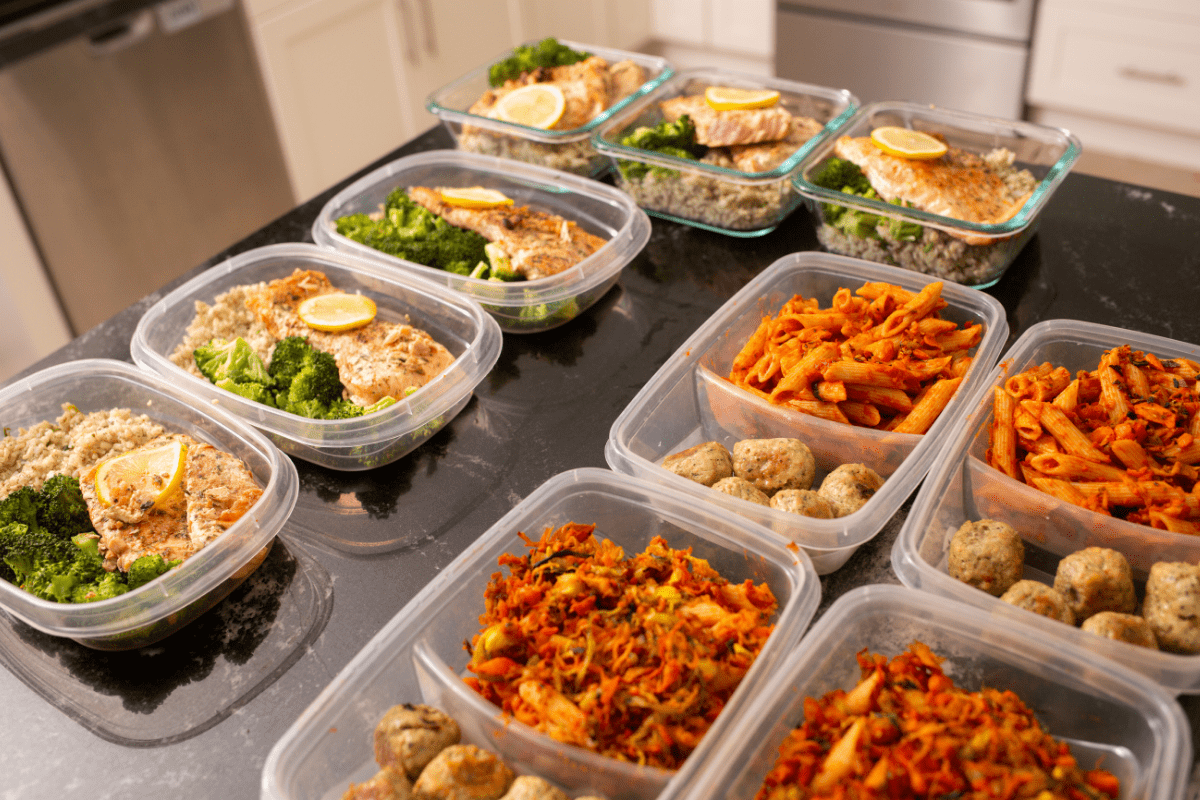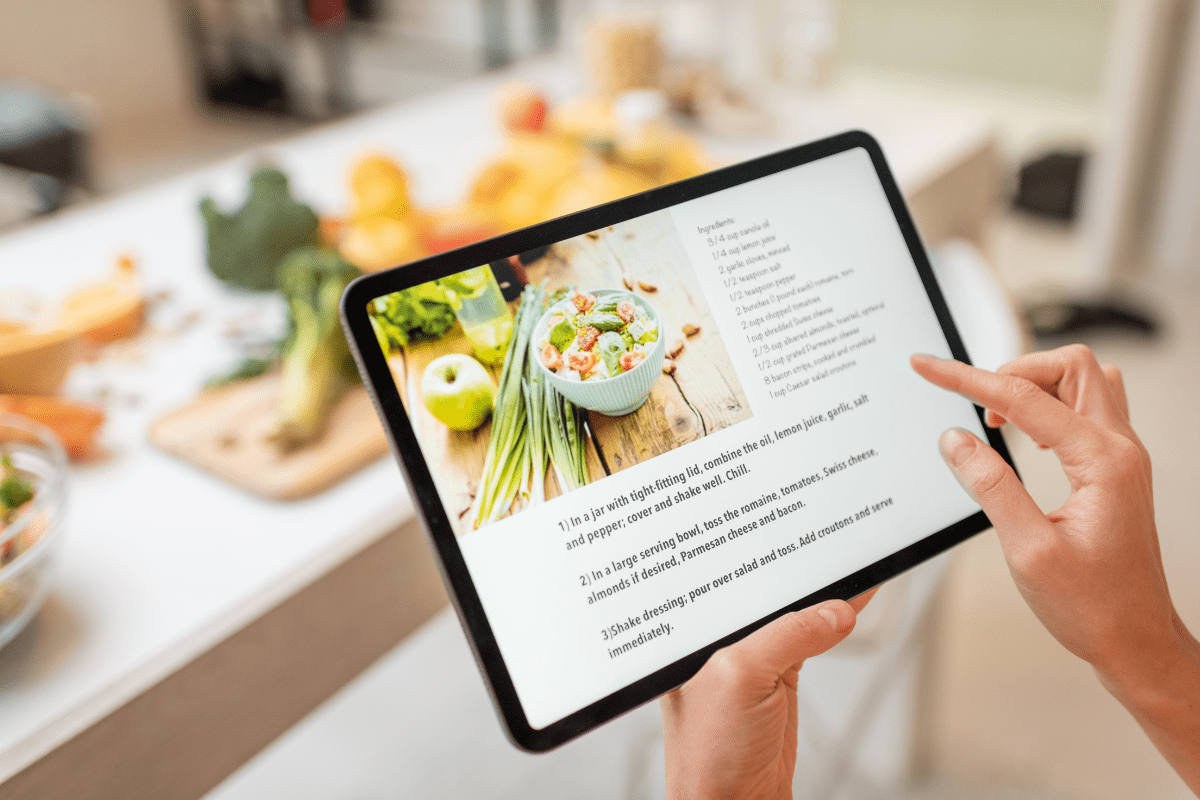Some nights we stare into the fridge like it’s a Netflix menu—thousands of options, nothing worth clicking. Meanwhile, the kids are auditioning for a Snickers commercial (“ You’re not you when you’re hangry ”), and the delivery app is whispering sweet nothings about $6.99 convenience fees. Meal prep can fix that mess without turning us into bland‑chicken robots.
Why meal prep saves sanity and lettuce
Meal prep is the culinary equivalent of putting your bills on autopay. By cooking several meals in one swoop, we swap seven nightly panics for a single, mildly chaotic session that finishes before the smoke alarm even wakes the dog.
The money math is equally attractive. A home‑cooked serving averages $4–$5, whilethe restaurant version hovers around $13–$15 per person. Multiply those differences by four family members and—presto—your vacation fund just found its missing zeros.
Meal prep also cuts food waste. The USDA estimates families of four pitch $1,500 worth of groceries into the bin annually. Planning portions means fewer wilted spinach funerals and more money for soccer cleats.
Time savings show up too. Batch‑cooked grains take 30 minutes once, not five times. Those reclaimed hours can fuel bedtime stories, side hustles, or the impossible dream of eight hours of sleep.
Finally, there’s nutritional sanity. When we choose ingredients on Sunday, Tuesday‑night us can’t sabotage Wednesday‑morning us with a 1,200‑calorie drive‑thru surprise. Meal prep locks good intentions in a Tupperware vault where they stay fresh—and judgment‑free—until needed.
Setting up the kitchen battlefield: gear and pantry
A carpenter never blames the hammer, but a meal‑prep rookie will curse a leaky container. Let’s armor up properly.
First, airtight glass containers: they survive the freezer, microwave, and rogue LEGO impacts. Choose uniform sizes that stack like responsible Jenga. Snap‑lock lids keep salsa from baptizing an entire lunch bag.
Next, sheet pans—the unsung heroes. Roasting a rainbow of veggies on one pan means less babysitting, fewer dishes, and caramelized edges that convert even cauliflower skeptics.
Instant‑read thermometers are insurance against poultry paranoia. Waiting for juices to “run clear” is code for eating at midnight.
On pantry duty, keep base carbs (brown rice, quinoa, whole‑wheat pasta) in labeled jars. Add protein backups like canned beans, tuna, and vacuum‑sealed tofu. With those staples, emergency dinners turn into “planned improvisation” rather than cereal.
Spice rack strategy matters more than culinary school. Stock globally versatile blends—taco seasoning, Italian herbs, garam masala—so Tuesday’s quinoa doesn’t taste like Sunday’s quinoa in witness protection.
Finally, freezer real estate is prime. Flat‑freeze soups in gallon bags laid on a cookie sheet; once solid, they file upright like culinary vinyl records. Rotate inventory monthly—nothing screams regret like a mystery slab of 2022 chili.
The science of balanced family plates
A balanced plate is less about Instagram symmetry and more about macro negotiation between taste buds and nutrition labels.
Registered dietitians will rattle off a 50‑25‑25 model: half non‑starchy vegetables, a quarter lean protein, a quarter quality carbs. We translate that into “color, chew, and comfort.” Color comes from veggies; chew from protein; comfort from carbs. No one revolts when all three show up.
Protein timing matters too. Grilling five pounds of chicken breasts on Sunday gives us protein Lego bricks that pop into salads, tacos, or pasta. For plant‑forward families, batch‑cook lentils or chickpeas; roast them crispy on Day One so they defend texture through Thursday.
Healthy fats round things out. Preportion smashed avocado with lemon juice to prevent Sad Brown Syndrome. Toast a sheet‑pan of nuts while the oven’s already hot; sprinkle them on everything the kids call “boring.”
Micronutrients hide in sauces. Blend spinach into pesto, carrots into marinara, or roasted red peppers into hummus. The kids think it’s “ninja ketchup,” and honestly, so do we.
Portion control is simpler when using divided containers—the adult‑size lunchables. The visual cue keeps us from backfilling empty space with “just a bit more mac ’n’ cheese.” Future us thanks present us for the jeans that still button.
Prep strategies for every schedule
Early‑bird edition
If alarms are your love language, start prep at dawn. Throw overnight‑marinated chicken into the oven while coffee’s brewing. Chop produce in daylight so you’re not dicing zucchini by the glow of the fridge bulb.
Night‑owl edition
Post‑bedtime meal prep doubles as quiet rebellion. Queue a podcast, light a candle, and roast sheet‑pan fajita veggies while tomorrow’s oatmeal soaks. The house is silent, the Wi‑Fi is strong, and nobody “just wants a little taste.”
Split‑shift edition
Families with rotating work schedules can deploy micro‑preps—ten‑minute tasks sprinkled through the day. Slice fruit during a conference call, steam rice while supervising homework, and sauté turkey while streaming practice highlights.
Weekend warriors
Block a two‑hour window on Sunday, call it “Kitchen CrossFit,” and crank through bulk cooking like a sous‑chef boot camp. A family assembly line—kids washing produce, partner grilling proteins—turns chore time into chaotic bonding. Bonus: built‑in taste‑testing.
Whichever schedule wins, consistency is the real hero. Set calendar reminders labeled “Feed the Future Us,” because Outlook guilt is powerful motivation.
Kid‑approved flavor hacks (or how to hide a vegetable)
Kids love control almost as much as sugar. Offering choice at plating—not cooking—ticks that box without derailing strategy.
Rainbow methodology works. When a lunchbox boasts three colors, the remaining beige item looks lonely and gets eaten out of pity. Slice bell peppers into traffic‑light strips; add blueberry “gems” for dessert vibes.
Dip diplomacy is huge. A tablespoon of yogurt ranch makes raw broccoli palatable. Homemade honey‑mustard marries roasted sweet‑potato wedges faster than any officiant.
Rename dishes with branding flair: “Power‑Ranger Pasta” packs spinach pesto; “Dino Nuggets 2.0” uses baked turkey meatballs shaped in a mini‑muffin tin. Marketing trumps nutrition lectures.
Texture tweaks help. Blend butternut squash into mac sauce—it thickens like velvet and sneaks in vitamin A. Shred zucchini into turkey burgers; moisture keeps patties juicy and invisible veggies stay under the radar.
Finally, let kids build their own bento once a week. They pick prepped components from the fridge: protein square, veggie scoop, carb cup, fruit topper. Predictably, they choose cookie‑cutter watermelon stars over celery, and that’s okay—vitamin C still scores.
Sunday power hour: one‑hour prep blueprint
We can’t conjure extra hours, but we can stretch 60 minutes like pizza dough. Here’s a blow‑by‑blow:
0–10 minutes: Preheat oven to 400°F. Start brown rice in the Instant Pot. Marinate chicken thighs with olive oil, lemon, and garlic.
10–20: Chop two trays of veggies—broccoli, carrots, bell peppers. Toss with oil and spices directly on sheet pans like lazy pros.
20–30: Slide chicken and veggies into the oven. While they roast, whip a quick Greek‑yogurt tzatziki and a maple‑mustard vinaigrette. Sauces elevate leftovers faster than fresh herbs wilt.
30–40: Set up a pot for hard‑boiled eggs. While water heats, blend frozen berries, oats, and milk into overnight‑oat jars.
40–50: Eggs cool in an ice bath; rice is done. Fluff rice, open two cans of black beans, season with cumin and lime.
50–60: Portion everything. Layer rice, beans, roasted veggies, and chicken into burrito bowls. Pack veggie sticks with hummus cups. Label containers like a meticulous sitcom dad.
When the timer buzzes, the fridge gleams with edible order and we retire like champions who still have half the weekend left.
Beyond dinner: breakfasts, lunches, and snacks that pack
Breakfast deserves more than panic‑granola. Bake a tray of spinach‑feta egg muffins; they reheat in 30 seconds and pair with fruit for a portable feast. Batch‑blend smoothie packs—freeze spinach, banana, and mango cubes in zip bags so the blender only meets liquids at go time.
Lunches thrive on theme weeks. Mediterranean Monday‑Friday means hummus pitas, cucumber‑tomato salads, and leftover chicken drizzled with tzatziki. Next week goes Tex‑Mex: quinoa taco bowls, roasted corn, and cilantro‑lime dressing. Themes simplify grocery lists and keep taste buds from revolting.
Snacks can end the vending‑machine romance. Roast chickpeas until crunchy, toss with taco seasoning, and store in glass jars for three‑day crispiness. Assemble DIY trail mix with nuts, whole‑grain cereal, and the chocolate chips mysteriously “left over” from cookie projects.
Hydration counts, so pre‑slice citrus and cucumbers into a pitcher for spa‑water bragging rights. Kids who balk at plain water magically drain bottles when they’re infused with “dragon scales” (aka orange rounds) and “mermaid coins” (aka cucumber slices).
Remember, 55% of Americans already order takeout weekly. When the midweek slump hits, our prepped fridge fights that statistic on our behalf—no guilt trip, no surprise fees, just dinner that’s ready before the Wi‑Fi finishes connecting.





